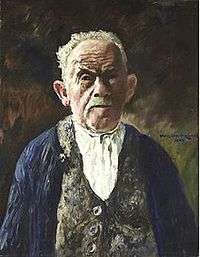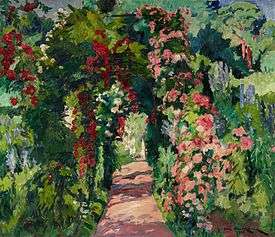Philipp Franck
Johann Heinrich Philipp Franck (9 April 1860, Frankfurt am Main - 13 March 1944, Berlin) was a German Impressionist painter, graphic artist and illustrator.


Biography
With his father's support, and insistence, he began by studying architecture at the Frankfurt Business College. When his father died, he decided to pursue his true artistic interests. Accordingly, at the age of seventeen, he enrolled at the Städelschule, where he studied with Heinrich Hasselhorst and Eduard Jakob von Steinle.[1] He focused on landscapes but, under Steinle's direction, also created illustrations for fairy tales.
In 1879, he moved to Kronberg im Taunus, where he joined the local artists' colony. While there, he befriended Anton Burger and took lessons with him until 1881. Franck, however, had his own strong opinions on the depiction of nature and went to the Kunstakademie Düsseldorf, where he had been recommended to Jakob Fürchtegott Dielmann.[1] He was there until 1886.
He then began to travel, eventually settling in Würzburg. After finding little success there, he moved to Berlin in 1892 and became a teacher at the Royal Art School.[1] In 1898, he was awarded the title of Professor. That same year, he joined with Lovis Corinth and Max Liebermann to help create the Berlin Secession. In 1902, his first wife died and, two years later, he married one of his students.
In 1906, Franck and his family moved to Halensee on the Wannsee, where he attempted to establish an artists' colony modeled on the one in Kronberg, but was unsuccessful. He returned to Berlin and became Director of the Royal Art School in 1915. In 1928, he participated in the International Exhibition at the Carnegie Institute.[1] His book of reminiscences, Ein Leben für die Kunst (A Life for Art), was published shortly after his death.
Family
Philipp Franck married, firstly, Katharina Ernst (1866-1902).[2] She died in August 1902, however. In 1904 he married his pupil Martha Kuhlo. Philipp Franck had four recorded children from his two marriages. A son from his first marriage was the scientist Hans Heinrich Franck (1888-1961).[3] His son from his second marriage, Carl Ludwig ("Carllutz") Franck (1904-1985), became a noted architect.[4]
The sculptor, Ingeborg Hunzinger (1915-2009) was a granddaughter.[5] The writer Julia Franck is a great granddaughter.[4]
References
- Brief biography @ Easy.db Archiv.
- Reinhard von Goetze (compiler), Berlin‑Lichterfelde. "Katharina Ernst, married Franck". Eine große Familie Ihr Stammbaum im Internet. Retrieved 2 October 2016.
- Hans-Georg Bartel. "Franck, Hans-Heinrich * 22.11.1888, † 21.12.1961 Chemiker, Präsident der Kammer der Technik". "Wer war wer in der DDR?". Ch. Links Verlag, Berlin & Bundesstiftung zur Aufarbeitung der SED-Diktatur, Berlin. Retrieved 2 October 2016.
- Julia Franck (23 July 2013). "On the Track of Family History". Jewish Quarterly. Archived from the original on 3 October 2017. Retrieved 2 October 2016.
- Reinhard von Goetze (compiler), Berlin‑Lichterfelde. "family tree Katharina Ernst, * 23.04.1866, † 22.08.1902". Eine große Familie Ihr Stammbaum im Internet. Retrieved 2 October 2016.
Further reading
- Ingeborg Becker, Manfred Grosskinsky (eds.), Vom Taunus zum Wannsee – Der Maler Philipp Franck (1860–1944). (exhibition catalog) Imhof, 2010 ISBN 978-3-86568-550-6.
- Wolfgang Immenhausen, Almut von Tresckow (eds.), Philipp Franck (1860–1944) – Werkverzeichnis der Gemälde. Edition Galerie Mutter Fourage. Imhof, 2010, ISBN 978-3-86568-574-2.
External links
| Wikimedia Commons has media related to Philipp Franck. |
- ArtNet: More works by Franck.
- Literature by and about Philipp Franck in the German National Library catalogue
- "From Taunus to Wannsee", exhibition at the Bröhan Museum, 2010-11.